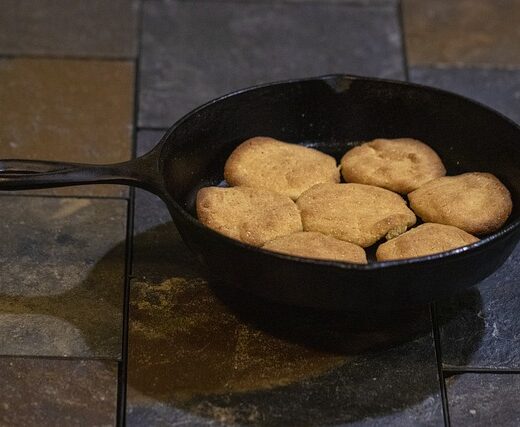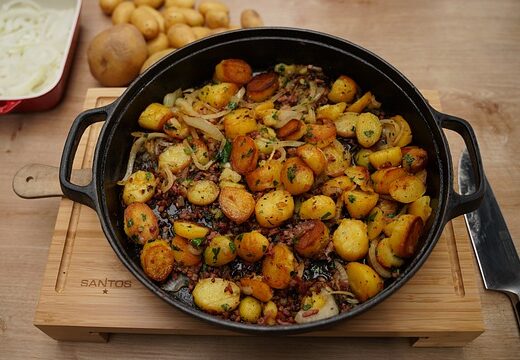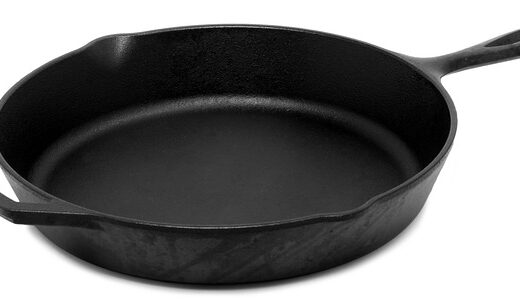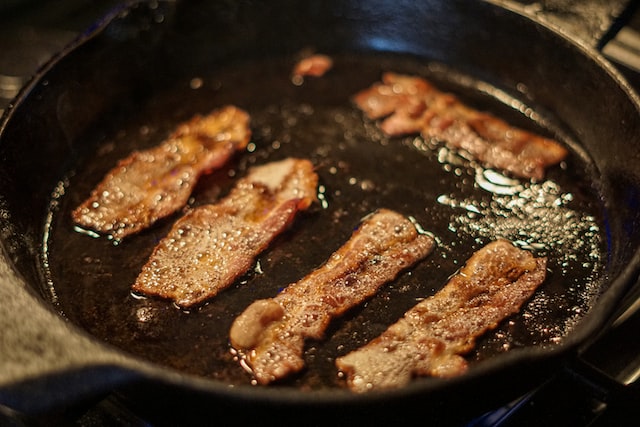If you’ve ever hesitated purchasing cast iron cookware because you’ve heard stories about its care and “feeding” (use a lot of oil), this is the post for you. While traveling through Tennessee, I saw a sign pointing to the Lodge Factory Outlet, which produces cast iron pans. I was on a tour bus, so I longingly peered out the window and added that destination to my bucket list in my head.
Over the years, I’ve developed a collection of these pans in all sizes and shapes. Whenever I was in a city with a Cracker Barrel location, I would visit and buy a specialty pan, and then have it shipped home since I didn’t want to pay more for the weight on my luggage. So you might say I’m a queen made of cast iron. I can cook a whole turkey, sizzling bacon, cornbread, apple pies, scorched hash, flawlessly seared steaks, bubbling pizzas, and golden-brown fried chicken with my cast iron cookware.

Nothing compares to a good, thick cast iron pan for heat retention. Due to its density, it takes a while to heat up. I let mine burn for around 5 to 7 minutes. It also doesn’t cool down too much when you add food. Thus, a cast iron pan will maintain its temperature close to its original level when a half-pound rib eye steak is added to it. It produces a thicker, crispier, and more evenly browned crust than a thin aluminum pan, which may experience a temperature decrease of up to 300°F. Similarly, you may get away with using a bit less oil when frying your chicken because the metal will quickly reheat the oil after the chicken cools it down due to the heat it retains.
Because it can be used in ovens, you can fry or sear, braise, and bake. Cornbread can be baked in a conventional skillet, a corn-stick pan, or a wedge pan, which allows each slice to have three crispy sides, and comes out with a lovely golden-brown crust. Even with moist ingredients, pies come out nicely crisp on the bottom. Because of its ability to retain heat, your pan’s heat will remain constant even if your oven temperature goes up and down (as in most ovens with a thermostat).

And speaking about durability, one of the few kitchen things that genuinely improve with age is cast iron cookware. There are no welded joints or rivets to wear out because the metal is cast from a mold in a single piece. The most fabulous pans have frequently been handed down through several generations, their well-worn surfaces having become as smooth and nonstick as those with Teflon coatings but without harmful chemicals.
Of course, there are certain drawbacks.
A cast iron pan will get perfectly seasoned after a few weeks of regular usage (I describe this as nonstick enough to cook eggs in). Food will adhere to it up until a good seasoning layer has formed. This holds even for the “pre-seasoned” skillets that are currently available but only have a good seasoning. You might anticipate the procedure to take a few months with less regular use. Like housebreaking a dog, it takes time, but picture how delighted you’ll feel when the first egg miraculously glides off the bottom.

Uneven heating occurs.
Contrary to popular opinion, cast iron does not distribute heat evenly; thus, the heat is confined to a small area around the source. Match the size of your pan to the burner size for best results to ensure the pan’s outer edges will get hot. A large burner and plenty of time are required to heat a cast iron pan.
It might rust.
While a good seasoning will avoid this, negligence (such as cleaning or failing to let it fully dry after use) might result in rust spots. We’ll talk about solutions to this minor issue later.
Acidic meals taste and look metallic after absorbing the iron’s flavor and color. Highly acidic foods cannot be cooked in them. Wine-based pan sauces and acidic foods like tomato sauce are not recommended until a thick layer of seasoning has formed.

It’s weighty.
There is no avoiding this one. The material’s ability to efficiently retain much heat energy in a short space is due to its density. Helper handles and other innovations are helpful, but smaller cooks will undoubtedly have trouble flipping or pouring. You might also want to have a look at Lodge’s Blacklock series, which is lighter.
It needs a thorough cleaning.
Cast iron cookware’s quality depends on how well it has been seasoned, so caution must be used when cleaning to avoid accidentally removing the seasoning layer; otherwise, you’ll have to start over.

Seasoning, caring for, and storing your cast iron cookware isn’t that complicated. Here is an overview:
First Step Preparation
The first thing to notice about your cookware is its surface. It will either have a black, slick-looking texture (for a seasoned pan) or a bullet-gray, dull finish (for an unseasoned pan).
Because it was produced in a sand-based mold rather than the solid molds that older cast iron was cast in, modern cast iron is rough. Some argue that seasoning these uneven pans adequately is impossible. I contrasted my gleaming, flawless 1930s Griswold, which I picked up at a flea market, with my ten-year-old Lodge skillet (which I bought new and seasoned myself. A new Lodge pan is pretty darn close to the old material and adequate for most uses, while the old stuff is undoubtedly more nonstick.
Therefore, correctly seasoning it is the key. More on how to do just that is contained in Part 2.

Leave a Reply